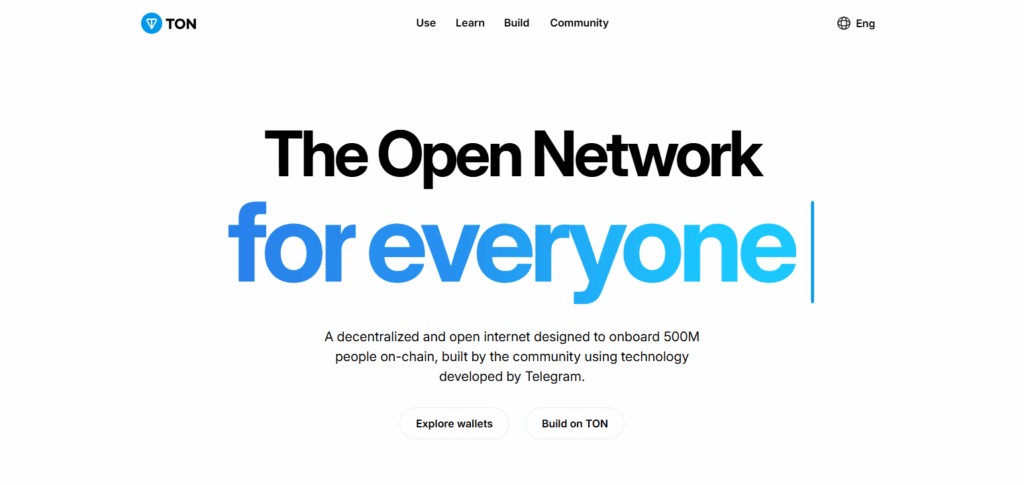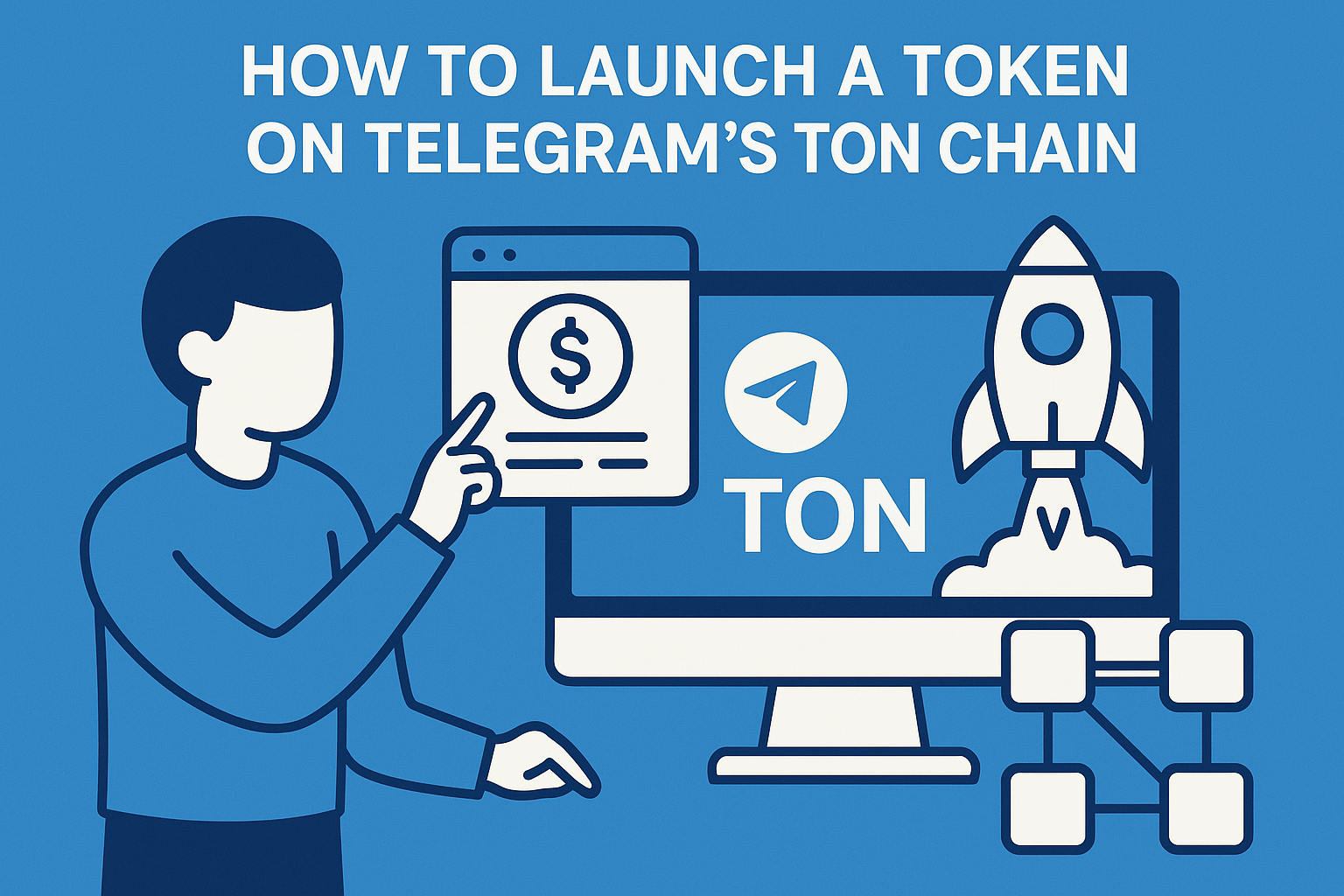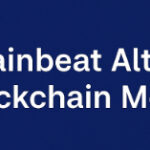In this article, I will explain the How to Launch a Token on Telegram’s TON Chain, a versatile blockchain optimized for speed, scalability, and Telegram ecosystem integration.
As of 2025, creating a Jetton token on TON is simplified for developers and entrepreneurs. Complete this guide to deploy and protect your token, then promote it within the TON ecosystem.
What is TON Chain?
TON Chain (The Open Network) has a high performing layer one block chain which was introduced by telegram and later made open source. It is made for acceleration, extensibility and tight integration with Telegram’s ecosystem. TON accommodates smart contracts, NFTs, DeFi, and a Jetton standard.

It has quick transactions, low-cost service, and integration within Telegram through mini applications and bots. By 2025, TON has become one of the best blockchains for developers and users to launch tokens, design dApps, and facilitate Telegram chat payments.
“How to Launch a Token on Telegram’s TON Chain in 2025”
1. Set Up a TON-Compatible Wallet
Install the TON-supported wallets Tonkeeper and Tonhub to download and store Toncoins. They also allow for the management of assets and smart contracts as well as dApps through the Telegram-integrated TON blockchain.
2. Acquire TON (TON Coin)
Buy TON from Binance or through Telegram’s @wallet bot. You will need it to cover the gas fees and the contracts to be deployed for the custom token exchange on the TON blockchain.
3. Access Token Deployment Tools
With a Telegram @jettoncreatorbot or Tact CLI, you can create and deploy tokens. They utilize the Jetton standard to allow developers and no-code users to create tokens with simplified interfaces and no complicated blockchain development knowledge.
4. Configure and Deploy Your Token
Set the token name, symbol, decimals, and total supply. Deploying will create a Jetton compliant smart contract token which you can publish on the TON blockchain, receiving a contract address and token page in return.
5. Share Your Token on Telegram
Promote Telegram Wallet’s capabilities for sending or receiving payments using @wallet. To capture interest, share your token’s contract address in conversational threads. Tokens have the potential to be embedded within Telegram’s numerous applications, bots, and other functionalities for exposure and utilization.
6. List and Advertise
Submit applications to be listed on TON DEXs like STON.fi, and DeDust. Advertise in Telegram communities, and provide utility such as staking or governance. If possible, add NFT or DeFi elements to boost your token’s traction and utility.
Why Launch a Token on TON?
Advanced Integration Capabilities with Telegram
Access a user base of over 900M with Telegram’s instant monetization features. Users can manage tokens and transact with them within chats using the native wallet feature.
Through Telegram’s Mini Apps and Bots, tokens can be distributed, and users can vote and interact seamlessly. Exploiting Telegram’s social graph offers unparalleled opportunities for organic user growth.
Performance and Scale
The Multi-Level Sharding Architecture allows for the processing of millions of transactions per second.
Low transaction fees, around a few cents, make micropayments and frequent interactions economical. The fastest blockchain in the world with a speed of up to 104,715 TPS.
Ecosystem for Developers
Creating tokens with no coding knowledge is possible with no-code platforms such as Panda Tool. Access to SDKs and documentation increases opportunities for new developers and startups.
Fundraising and liquidity can be obtained through TONStarter, TONSale, STON.fi and other launchpads and DEXs.
Community First
Offer rewards for community and governance participation with Community Tokens. Perfect for in-game currencies, NFTs, and tokenized social activities, GameFi and SocialFi.
Toncoin is used for the distribution of Telegram advertisement revenue, demonstrating real-world uses.
Ecosystem Funding
$50K grant for migrating projects with a $250M ecosystem fund from the TON Foundation. $200M incentive for participants of The Open League.
Airdrops & Staking Support: Integrated mechanisms for stakeholder participation and token distribution.
Common Mistakes to Avoid
Skipping Smart Contract Testing Not testing a token on testnet means a live deployment is guaranteed to result in unintended and often irreversible errors. Every function, be it minting or transferring, needs to be rigorously tested.
Incorrect Parameter Configuration In addition to testing, every parameter that’s set for a token like total supply and decimals needs to be verified. They are set in stone post deployment; hence, careful editing is a must.
Deploying Without Adequate TON for Gas It’s a must to have enough TON tokens in your wallet, for both the deployment and the subsequent transactions. Failure to do so guarantees failed smart contract deployment and transaction execution.
Using Unverified or Copied Code Smart contracts serve vital functions in modern protocols, and every single line needs to be well understood and extensively verified. Every instance of using a smart contract without it being original is a surefire way of incorporating bugs and exposing it to various vulnerabilities.
Poor User Interface or Accessibility Placing too many restrictions and failing to integrate the token into Telegram bots or dApps dramatically lowers the accessibility for users and needs to be rectified for better user engagement.
Ignoring Telegram Community Engagement It’s vital to utilize Telegram and build your community around the token, because failing to do so significantly lowers the chances of adoption and undermines the trust of your users. Channels, groups, and bots should all be used without hesitation.
Unfamiliar with the Legal and Regulatory Landscape Getting into trouble with the law can stem many different types of violations. For example, launching a token without fully grasping KYC and AML or the token classification laws in your region can lead to some trouble. Approach each of the KYC and AML laws and token classification laws in your region with ample scrutiny.
Missing a Strategy for Sustained Value Creation or a Roadmap for the Future Failure is common among projects that lack a well-defined and descriptive utility for the token and the plan for the future. Explain the intention behind the token as a utility, if it’s DeFi, payment, or NFT, and make it known with clarity.
Security & Compliance Considerations
Smart Contract Auditing Token contracts need to be secured. Maintain a positive reputation by looking for common vulnerabilities such as reentrancy attacks, integer overflows, or incorrect token logic through a manual audit or professional services. Exponential trust-building through audits is key to preventing costly exploits.
Use Verified Tools and Libraries Unfamiliar third-party scripts or generators are best avoided as they use unofficial development tools like TON, FunC, ton-cli, to mention a few. Verified tools eliminate the risk of code or bugs insertion by malicious actors.
Securing Private Wallets and Keys Hardware wallets protect deployment keys and are best to use. Token loss, or unauthorized transactions are irreversible when private keys are inaccessible.
Rate Limits and Anti-bot Protection Staking, token airdrops, or any utility function needs to come with anti-bot mechanisms. Abuse by bots can be contained through validation as well as rate check for wallets, preventing Sybil attacks.
Adhere to Local Compliance Guidelines Keep your token compliant as utility, a security, or a payment token for your locality. Observe all relevant laws such as tax reporting, KYC (Know Your Customer), and AML (Anti-Money Laundering).
Conditions for Usage and Disclaimers of Legal Nature If your project solicits funds or provides staking rewards, ensure you highlight a legal disclaimer for users. Utilize privacy policies and terms of use to mitigate legal claims.
Consistent Evaluation and Revisions Watch for your token smart contract’s abnormal activity on-chain. While TON contracts have limited upgradability, you can design governance or migration capabilities for critical situations.
Trust is Earned, and Transparency is the Tool Disseminate your source code, contract address and audit reports via GitHub and TON Explorer. Direct community engagement counteracts FUD, enhancing project credibility.
Conclusion
For developers wishing to leverage a rapidly growing blockchain with effortless integration to Telegram, launching a token on Telegram’s TON Chain in 2025 presents a golden opportunity.
A developer can create a digital asset by taking the necessary steps—from preparing the workspace to writing smart contracts, conducting tests, deploying, and promoting the token.
A developer should avoid legal issues and common pitfalls, and ensure strict compliance with all regulations, especially in legal aspects, on every step.
Your TON-based token can have a prominent position in the evolving Web3 industry with adequate preparation and proper adherence to the guidelines and participation of the community.
What is required to launch a token on the TON blockchain?
You’ll need a TON-compatible wallet (like TON Wallet or TONKeeper), the TON CLI, basic coding knowledge (FunC or Fift), and some TON tokens to cover deployment fees.
Can I launch a TON token without coding skills?
Yes, platforms like Jetton Factory and [Ton.app] allow you to create tokens using a no-code interface. You simply set parameters like name, supply, and symbol.
What is a Jetton token?
Jetton is the token standard on TON, similar to ERC-20 on Ethereum. It defines how tokens behave and interact across the TON ecosystem.
How much does it cost to launch a token on TON?
Launching a token requires a small amount of TON for gas fees, usually less than $1, depending on network load and contract complexity.
Is it possible to test my token before going live?
Yes, you can deploy your token to the TON testnet first to simulate contract behavior and confirm functionality before mainnet deployment.









